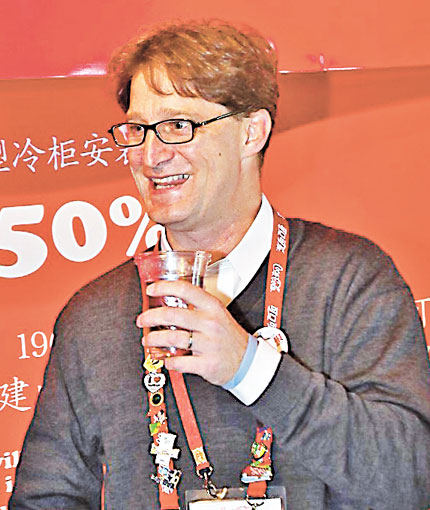Businesses benefit from Expo stage
Private enterprises in China create more than 60 percent of tax revenue. China's private enterprises, sandwiched between big-capital, big-name state-owned companies and multinational companies, are fighting to move up the production chain for more lucrative and high-technology business.
Ted Ryan
Director of Coca-Cola Museum
Ryan visited the Coca-Cola Pavilion in Shanghai this month to select meaningful collections and Expo souvenirs to be placed in the Shanghai Expo museum, the Coca-Cola Museum in Atlanta, US and Chinese bottlers' museums.
"The Coca-Cola company has always used World Expo to highlight innovation and hopes to create significant and happy memories for China," said Ryan.
More than 1.02 million people have visited the Coca-Cola Pavilion themed "Happiness Factory" in Zone D of the World Expo, according to the pavilion.
Visitors can experience magic refreshments and be inspired by the Arctic cold with SuperChill, a self-icing coke.
At Expo 2010, Coca-Cola exhibited retail equipment with advanced technology including a Freestyle Vending Machine. This sleek touch-screen operated vending machine allows you to select from more than 100 brands.
"I believe the new technology displayed in the Coca-Cola Happiness Factory will lead the beverage industry and beverage equipment development," Ryan said.
 |
|
Ted Ryan - Director of Coca-Cola Museum |
Sun Jun
Director of the Private Enterprises Joint Pavilion
The pavilion started as a pure coincidence but ended as a larger-than-life success, Sun said.
At the preparation stage, a multinational company unexpectedly canceled its Expo project, leaving one vacancy for possible bidders. Then 16 private Chinese businessmen considered the opportunity and applied to fill the vacancy.
"It's a destined coincidence. With China's private business so dynamic and booming, it wouldn't be right not to see the involvement of the private business sector," said Sun.
"The Expo turned out to be a better-than-expected platform for Chinese private business to showcase its evolution," Sun said. "One of the biggest resources is the coming together of entrepreneurs."
The pavilion attracted 2.1 million visitors, five percent of which are VIPs such as government officials and entrepreneurs, according to Sun.
The former can offer the necessary support needed for the growth of the sector, while the latter reckon that the sector should form a team rather than fight independently on different frontlines.
A young talent program, entrepreneur training and financing are all listed as post-Expo programs between the Chinese private companies to take advantage of the resources they gained during the exhibition.
Akioka Eiko
Head of the Japanese Industry Pavilion
It's the first time for private Japanese firms to jointly attend an overseas Expo besides Japan's national pavilion.
"It's the best method to showcase the latest technologies and modern lifestyle in the way we understand," said Akioka.
The pavilion is very consumer friendly, with themed theaters and eight major exhibition areas sponsored by Japanese businesses, as well as a Japanese-style restaurant.
During the Shanghai Expo, the combined traffic to the pavilion reached more than 5.54 million by the final week.
It's the place for visitors to consider "the wonderful life in Japan and our understanding of 'better city, better life,", said Akioka.
The highlights of the pavilion include golden toilets, climbing robots and kaiseki-ryori dinner, which costs 3,000 yuan (US$448) per person.
More than 3,000 people have tasted Japanese food in the restaurant, which has been fully booked this week.
In the pavilion, about 500 staff are from China and half of them are students.
"I highly appreciate their work and hope the young contribute more to the China-Japan cultural bridge," said Akioka.
The 21 students, who work in the restaurant, will be invited to Japan in December, according to Akioka.
 0
0 







Go to Forum >>0 Comments